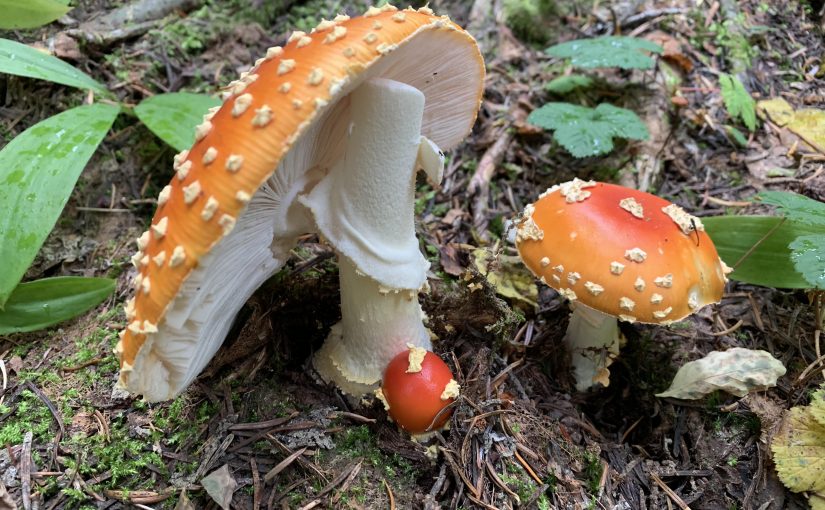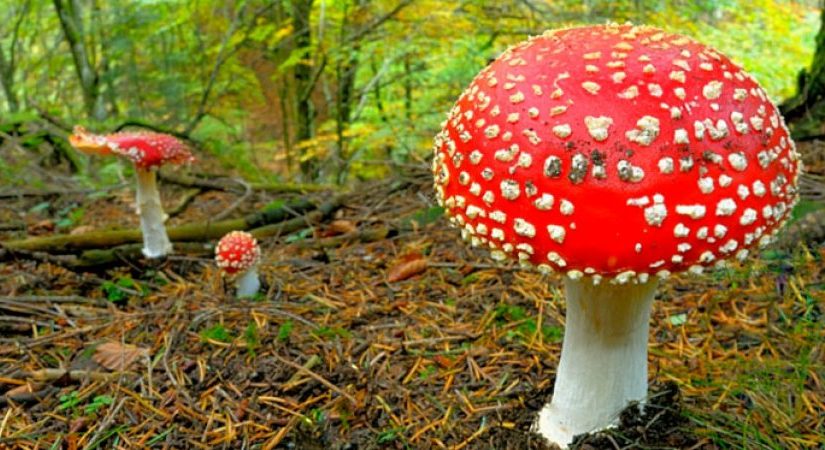por Oliver Sutton
La amanita muscaria es la promesa de un estado alterado de conciencia escondida a plena vista. Con su gorra roja moteada en blanco, el también llamado matamoscas, es quizás el hongo más reconocible de todos y, como tal, ocupa un lugar especial en nuestro imaginario colectivo. De Disney a los Pitufos y hasta Super Mario pasando por los ornamentos decorativos de jardín, la imagen de la amanita muscaria parece tener una cualidad arquetípica peculiar.
Sin embargo, es un arquetipo profundamente ambiguo. Al ser tan atractivo, no solo invita a la mera apreciación estética, sino a la posibilidad de una comunión más profunda aunque son estas mismas cualidades las que generan una alarma que advierte de su toxicidad y peligro, haciéndolo también visceralmente repulsivo.
Se trata de un hongo venerado como sacramento por los chamanes de Escandinavia y Siberia y vilipendiado como venenoso por aquellos para quienes los hongos solo dividen en comestibles y no comestibles. Pero la división no va sólo divide de temerosos y osados sino que es extensiva a la comunidad psicodélica. Gordon Wasson, el etnomicólogo a quien se le atribuye la introducción de Psilocybe Cubensis en Occidente, lo describió en su último libro como «el enteógeno supremo de todos los tiempos», convencido de que el Soma, el sacramento descrito en los Vedas de la India era, en efecto, amanita muscaria. Por el contrario, el gran Terence Mckenna, admirador de Wasson que no se quedó corto en la experimentación con sustancias psicoactivas, lo describió como un ‘mal viaje’ aduciendo que era más probable obtener un dolor de estómago que una intoxicación extática de su consumo. La misma ambivalencia aparece reflejada en las experiencias de viaje con amanita muscaria en Youtube y en los foros de páginas como The Shroomery. También sorprende cuán relativamente olvidado está este hongo; a pesar de su prominente aparición en nuestras mitologías y medios, de ser una especie autóctona de toda Europa, y de la existente tradición europea de su uso chamánico, parece que hay pocos interesados en ingerirlo. Supongo que la razón es precisamente su ambigüedad, especialmente en lo respectivo a la toxicidad. Por eso, cuando comencé a investigar la amanita muscaria con la idea de tomarla, esto era lo que más me preocupaba.
________________
No hay tanta información sobre amanita muscaria como sobre hongos psilocybe y tampoco existe un nivel de consenso sobre cuestiones tales como cómo prepararlo, su toxicidad o qué esperar mientras se está bajo su influencia. Sin embargo, después de buscar en muchas webs, leer varios artículos y foros y ver y escuchar numerosas charlas y relatos diferentes, comencé a desarrollar un plan basado en la información que estaba recaudando. Lo primero que hay que decir es que parece que se ha exagerado el problema de la toxicidad. Hay muy pocos ejemplos concretos de envenenamiento por consumo de amanita muscaria. Encontré uno o dos casos en revistas científicas, dado el número de personas que deben ingerir este hongo cada año, realmente es una ocurrencia muy rara. Lo que es más común son testimonios de calambres de estómago, náuseas y / o vómitos. Parece que el vómito es común a la mayoría de las experiencias con amanita muscaria, y como tal, simplemente se debe aceptar que es un purgante al igual que la ayahuasca.
En cuanto a los calambres estomacales y las náuseas, la mayoría de las personas informan de que estos síntomas ocurren en las primeras y que desaparecen con relativa rapidez. Existe bastante consenso en que la preparación adecuada del hongo es clave para reducir estos efectos secundarios no deseados. Comprender por qué requiere una breve mirada su farmacología: entre los ingredientes activos que contiene la amanita, los dos clave son el ácido iboténico y el muscimol. El muscimol es el componente psicoactivo, mientras que el ácido iboténico es en gran parte responsable de la toxicidad del hongo. En su estado fresco, la amanita contiene una proporción mucho mayor de ácido iboténico. Sin embargo, tanto el secado como el calentamiento del hongo catalizan un proceso de descarboxilación durante el cual el ácido iboténico se convierte en muscimol. Como consecuencia, hubo un consenso casi universal de que la amanita muscaria no debe consumirse fresca, ya que de este modo, ingerimos una proporción mucho mayor de la toxina principal y poca sustancia psicoactiva. Parece ser que los chamanes finlandeses resolvieron esto bebiendo la orina de los renos que se alimentan de los hongos, mientras que a su vez, los aldeanos comunes bebían la orina del chamán. Afortunadamente, existen formas más sencillas de descarboxilar el ácido iboténico.
Primero, como hemos señalado anteriormente, debemos secarlos. Luego, antes de consumirlos, podemos hacer una decocción poniéndolos en agua que se caliente justo por debajo de la temperatura de ebullición y mantenerlos a esa temperatura durante unos treinta minutos. Si bien esto probablemente no eliminará su efecto purgante, asegurará que una cantidad suficiente de ácido iboténico se convierta en muscimol para minimizar los efectos más tóxicos. Habiendo dicho todo esto, también he visto una publicación en Youtube de un usuario experimentado que insiste en que el ácido iboténico es una parte integral de la psicoactividad del hongo y que, como tal, el objetivo no debería ser eliminarlo por completo. Mi enfoque ha sido secarlo, hacer la decocción y tomarlo en dos veces, primero solo 5 gramos y 15 gramos a los pocos días, puesto que me pareció sensato tomar primero una dosis más ligera dada la reputación del hongo de ser altamente impredecible en cuanto a dosis y efectos probables. Mientras escribo esto, la decocción se está esperando en el altar de la habitación y mi compañera está avivando el fuego, no exactamente emocionada ante la perspectiva de lo que estoy a punto de hacer.
________________
Hablé demasiado pronto. El efecto del brebaje fue muy leve. Mis sentidos estaban un poco alterados, era notablemente más difícil concentrarme en tareas simples, mi sentido del olfato mejoró y hubo cierta distorsión en la percepción del tiempo. Pero todos estos efectos fueron bastante sutiles y no tuve la sensación de haber conectado con el hongo. Sospecho que si la infusión de 5 gramos secos ha sido tan suave, la de los 15 gramos restantes no dará lugar a un viaje poderoso. Por suerte, no experimenté náuseas ni molestias abdominales, y esto es alentador para la toma de la dosis más alta mañana. Aunque de todos modos 5 gramos fuese un viaje liviano, me pareció demasiado liviano y me pregunto por qué no fue más intenso. Una posibilidad puede ser la mezcla de hongos que utilicé. No busqué la amanita, más bien vino a mí de varias maneras. Una seta grande, seca de 9 gramos de peso, había sido recogida en Collserola, cerca de Barcelona, y me la regaló una amiga hace un año. Otro amigo me trajo unas cuantas amanitas secas hace un par de meses del bosque alrededor de la casa de sus padres en Lübeck, Alemania. Y mi pareja y yo encontramos tres más mientras buscábamos un perro perdido en el bosque cerca de donde vivo en Alpens. De estas, dos eran bastante viejas y la otra era un espécimen perfecto.
Hay una serie de variables que podrían haber influido en la potencia: la cantidad de tiempo que guardé el hongo de Collserola, el tiempo que tenían los que encontré en Alpens, o la variabilidad de la potencia de la amanita muscaria que aparece documentada en función del lugar y el tiempo en que se haya encontrado. Otra posible explicación es que algo fuese mal con la decocción aunque este método fue bastante bien documentado y reportado como efectivo. Seguí lo que parece ser el “procedimiento estándar” con amanita muscaria: piqué los hongos secos tan finamente como se pude y luego los calenté en agua que mantuve justo por debajo del punto de ebullición a fuego lento durante aproximadamente media hora. Esto debería haber funcionado, puesto que tanto el ácido iboténico como el muscimol son altamente solubles en agua. Efectivamente, la infusión resultante tenía un fuerte sabor a carne y hongos. Me preguntaba si debería haberme comido la capa de hongos que quedó después haber hecho la decocción, pero si los compuestos activos son tan solubles en agua como parece sugerir toda la literatura, no debería haber tenido mucha importancia. Otra posibilidad es que los efectos psicotrópicos no se manifiesten hasta que se haya alcanzado un umbral, y que si bien los efectos apenas se notan a los 5 gramos, el infierno se desate a los 15. Sea cual sea el motivo de la ligereza del viaje del domingo, mañana tomaré tres veces más. Si la lógica prevalece, supongo que cabría esperar una experiencia exactamente tres veces más potente que la experiencia anterior, lo cual sería aun así un viaje ligero. Sin embargo, en mi experiencia, las plantas psicoactivas no se rigen por nada lineal como la lógica. Las circunstancias en que sucede la toma tienen una gran influencia tanto en la calidad como en la potencia de la experiencia. Lo mismo puede decirse de la actitud que se adopta ante el acto de coger el hongo. Ciertamente, mi experiencia corrobora que con los hongos psilocybe, la preparación mental puede marcar la diferencia entre un viaje poderoso y rico en significado y un malestar estomacal acompañado de un sentimiento insatisfactorio de extrañeza. Con esto en mente, volví al lugar donde encontramos la amanita muscaria para pedir a su micelio que se me revelara. Me puse de rodillas y después de unos cánticos que pretendían despertar la tierra debajo de mí, me vino a la mente un encantamiento que le canté a la tierra y al bosque y también a mi futuro yo, que estaría bajo el influjo de la amanita muscaria dos días después.
“Amanita Muscaria Amanita Muscaria, te pido te pido, que te muestres que te muestres, a mí a mí.”Este es el cántico que llevaré conmigo cuando vuelva a tomar el hongo. Será maravilloso si la dosis más alta y las invocaciones que he hecho conspiran para llevarme a algún lugar inesperado. Estoy esperando a que llegue mi pareja, que quería estar presente por si la cosa se pone difícil. He hecho todo lo que he podido para prepararme para un encuentro con esta entidad, la más evasiva. Todo lo que queda es beber la decocción y estar abierto a lo que sea que pueda presentarse.
________________
Bebí la decocción frente al altar en nuestro jardín mientras mi compañera se ocupaba de plantar guisantes. Toqué suavemente el tambor y, casi en susurros, canté el encantamiento. Todavía calentaba el sol de la tarde y el jardín estaba bañado por el resplandor anaranjado de hora del día. Como en la ocasión anterior, me di cuenta del efecto de la amanita muscaria después de no más de veinte minutos tras la toma. Esos veinte minutos se convirtieron en una hora y media y se hizo evidente que, si bien los efectos eran ciertamente más fuertes que en la ocasión anterior, no iba a haber un salto cuántico en cuanto a efectos. La dosis era proporcionalmente más fuerte: la lógica, al parecer, había prevalecido. En términos de potencia, era equivalente a estar ligeramente colocado o un poco borracho. Pero la calidad de la experiencia no fue la misma. Después de que mi pareja terminara con los guisantes, yo concluí mis encantamientos y nos dispusimos a hacer fuego.
En todo momento pude permanecer activo y comprometido con la tarea que tenía entre manos, pero había una cualidad un poco de ensueño en todo. Podía mirar fijamente el fuego durante largos períodos y disfrutaba de permanecer quieto y simplemente observar. Traté de identificar y formular lo que era específico de esta experiencia pero esa noche no pude hacerlo. Sin embargo, al día siguiente, cuando volvimos a trabajar en el huerto, pude articular mejor la particularidad de mi experiencia con la amanita. En primer lugar, trabajaba de manera extremadamente lenta y prefería detenerme y mirar las cosas. Era un día soleado y me senté un rato absorto viendo las hojas caer de nuestro árbol de caquis.
(El árbol de caquis)
Me encantó el juego de luces y sombras entre las hojas amarillentas y la forma en que el viento las agitaba y las hacía susurrar. Pronto se hizo evidente que todo lo que le faltaba a la amanita en términos de potencia, lo compensaba en términos de duración. Había pasado una noche entera y estaba claro que todavía estaba bajo la influencia del muscimol. Entonces pude identificar mejor qué era específico de la intoxicación por este hongo.
Tiene un efecto soporífero pero sin embotar la conciencia o hacer que uno esté menos alerta. De hecho, la sensibilidad a la información sensorial se incrementó: los colores eran más brillantes y los sonidos más definidos, pero todo tenía la calidad de un sueño lúcido. No era fácil concentrarse en las tareas y los planes, pero sentarse, mirar y escuchar se convirtió en un fin en sí mismo y una actividad totalmente absorbente. Pasé la mayor parte de la mañana sentado en el banco mirando el árbol de kaki, leyendo esporádicamente o dormitando, pero el rastro inconfundible de la amanita era la cualidad vívida y onírica de la conciencia que lo impregnaba todo. Abandoné los planes que tenía para el resto del día y disfruté de la sensación hasta que al final de la tarde me sentí somnoliento y terminé durmiendo temprano. Solo puedo especular sobre cómo podría haber sido un viaje más potente, pero esta cualidad de ensueño se menciona con bastante frecuencia y se lleva al extremo, imagino que podría resultar en un efecto disociativo, por lo que uno ya no se identifica con lo que está haciendo, pensando o incluso sintiendo. Si tuviera la oportunidad de tomar amanita muscaria de nuevo, probablemente solo la secaría antes de comerla, saltándome la decocción, incluso si me costara un dolor de estómago. Dicho esto, no tengo prisa por repetir la experiencia. Una semana después, tomé cinco gramos de cubensis secas y, como ha sucedido tantas veces antes, disfruté de un viaje profundo, poderoso, purificante y significativo.


